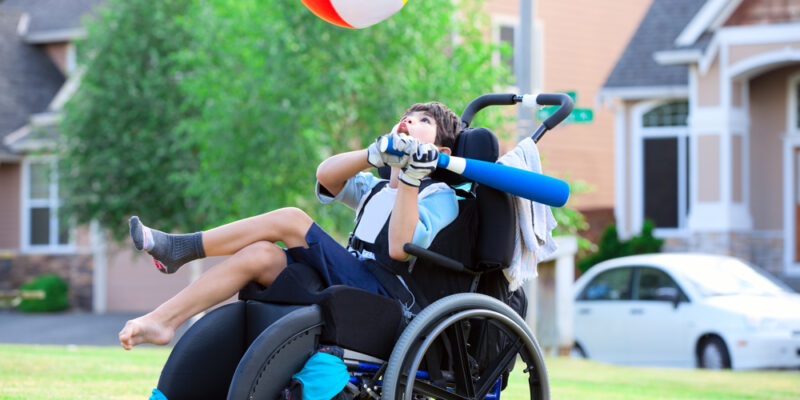Defining Erb’s Palsy: A Medical Overview
Erb’s Palsy, also known as brachial plexus birth palsy, is a condition that primarily affects newborns, often resulting from complications during childbirth. It is characterized by weakness or paralysis in the arm, which occurs when the group of nerves around the shoulder, known as the brachial plexus, is injured.
The severity of Erb’s Palsy can vary, with some children experiencing mild symptoms that improve over time, while others may face more significant challenges requiring ongoing care. The condition is typically diagnosed shortly after birth, and the treatment plan may include physical therapy, surgery, or both, depending on the extent of nerve damage.
Families dealing with Erb’s Palsy may encounter a range of emotions and challenges as they navigate the medical landscape. It is crucial for parents to understand that while the condition can be daunting, there are resources and support systems available to help manage the impact on daily life. Moreover, in cases where medical negligence is suspected to have caused the condition, families may explore legal options for compensation.
The Emotional Toll on Families
The journey of a family dealing with Erb’s Palsy is often marked by a spectrum of emotions, ranging from initial shock and disbelief to a persistent sense of concern for the child’s future. The diagnosis can bring about a profound sense of vulnerability and a need for constant vigilance in ensuring the child’s well-being.
- Grief and Guilt: Parents may experience grief over the loss of expected norms and guilt thinking they could have done something to prevent the condition.
- Stress and Anxiety: The demands of daily care and the uncertainty about the child’s recovery can lead to heightened stress and anxiety levels.
- Sibling Dynamics: Siblings might feel neglected or bear the weight of additional responsibilities, which can alter the family dynamics significantly.
It is crucial for families to seek emotional support through counseling, support groups, or connecting with other families facing similar challenges. Acknowledging and addressing these emotional impacts is a vital step towards building resilience and fostering a nurturing environment for the child and the entire family.
Adapting to New Family Dynamics
When a family member is diagnosed with Erb’s Palsy, the entire family dynamic can shift. Parents and siblings may need to take on new roles to support the child’s needs. It’s essential to approach these changes with flexibility and understanding.
- Open Communication: Maintaining an open dialogue within the family helps everyone express their feelings and concerns. It’s important for each member to feel heard and supported.
- Shared Responsibilities: Dividing care and household tasks can prevent caregiver burnout and promote a sense of teamwork.
- Quality Time: Ensuring that each family member still receives individual attention can strengthen bonds and reduce feelings of neglect or jealousy.
Families may also benefit from seeking external support, such as counseling or joining support groups. These resources can provide valuable coping strategies and a sense of community. Adapting to new family dynamics is a gradual process, and patience is key to navigating this journey together.
Daily Care Strategies for Children with Erb’s Palsy
Creating a Supportive Home Environment
A supportive home environment is crucial for children with Erb’s Palsy, as it can significantly enhance their quality of life and promote better recovery outcomes. To achieve this, families can start by organizing the living space to accommodate the child’s needs, ensuring that it is safe and easily navigable.
- Accessibility: Install ramps or stairlifts if necessary, and arrange furniture to create clear pathways.
- Safety: Use non-slip mats and secure loose rugs to prevent falls, and consider padding sharp corners.
- Comfort: Provide supportive seating and bedding that caters to the child’s physical requirements.
In addition to physical modifications, emotional support is equally important. Regular family activities that include the child and acknowledge their capabilities can foster a sense of belonging and boost self-esteem. Open communication within the family about the challenges and successes of living with Erb’s Palsy encourages a nurturing atmosphere where the child feels valued and understood.
Physical Therapy and Exercise Routines
Physical therapy is a cornerstone in the management of Erb’s Palsy, aiming to improve joint mobility and muscle strength. A tailored exercise routine, developed by a pediatric physical therapist, can significantly enhance a child’s ability to perform daily activities.
- Initial Assessment: A thorough evaluation is essential to create a personalized therapy plan that addresses the child’s specific needs.
- Passive Exercises: These involve moving the affected limb through its range of motion without the child’s active participation, to maintain flexibility.
- Active Exercises: As strength builds, children are encouraged to engage in exercises that require their active effort, promoting muscle development and function.
- Splinting: In some cases, splints may be used to support the limb, prevent joint stiffness, and improve alignment.
It’s important for families to integrate these exercises into their daily routine, ensuring consistency and maximizing the benefits of therapy. In more severe cases, surgical intervention may be considered to repair nerve damage and improve arm function. Collaboration with healthcare professionals is key to determining the most effective treatment plan for each child.
Assistive Devices and Accessibility Modifications
For children with Erb’s Palsy, assistive devices can play a crucial role in fostering independence and improving quality of life. These devices are designed to support the child’s affected limb and can range from simple modifications to high-tech equipment.
- Splints and braces help stabilize the arm and can improve the child’s ability to perform daily tasks.
- Adaptive clothing with Velcro closures and one-handed zippers can make dressing easier.
- Modified eating utensils are crafted to require less grip strength, enabling children to feed themselves with greater ease.
Accessibility modifications in the home are equally important. Families may need to consider changes that make the living space more accommodating for their child’s needs.
- Ramps and stairlifts can be installed to ensure the child can navigate different levels of the home without assistance.
- Bathroom adaptations, such as grab bars and shower seats, enhance safety during personal care routines.
- Adjustable furniture, like desks and beds, can be tailored to the child’s comfort and accessibility requirements.
By integrating these assistive devices and making thoughtful modifications to their home, families can help their child with Erb’s Palsy lead a more independent and fulfilling life.
Communication and Social Interaction
Fostering Effective Communication Skills
Effective communication is a cornerstone of a child’s development and is particularly crucial for children with Erb’s Palsy. It is essential for families to encourage and support the development of these skills from an early age. Here are some strategies to enhance communication:
- Encourage Non-Verbal Communication: Start by recognizing and responding to non-verbal cues. Gestures, facial expressions, and body language can all convey meaning and should be encouraged.
- Use Assistive Technology: There are various tools and apps designed to aid communication. These can range from simple picture boards to sophisticated speech-generating devices.
- Create Opportunities for Interaction: Regularly engage your child in conversations and social interactions. This can include storytelling, playing interactive games, or participating in group activities.
- Practice Patience and Active Listening: Always give your child time to express themselves without rushing them. Listen actively and acknowledge their efforts to communicate.
- Seek Professional Guidance: Speech therapists can provide tailored strategies and exercises to improve communication skills. Their expertise can be invaluable in addressing the unique challenges faced by children with Erb’s Palsy.
By integrating these approaches into daily life, families can help their children with Erb’s Palsy develop the confidence and skills necessary for effective communication.
Encouraging Social Participation
Children with Erb’s Palsy may face unique challenges when it comes to social participation. However, with the right support and encouragement, they can engage fully in social activities and form meaningful relationships. Parents and caregivers can play a pivotal role in facilitating social interactions by taking proactive steps.
- Organize playdates with other children who are understanding and inclusive. This can provide a safe and comfortable environment for the child to interact and make friends.
- Enroll the child in group activities or clubs that align with their interests. Whether it’s art, music, or sports, shared interests can be a powerful catalyst for social connection.
- Communicate with educators and activity leaders about the child’s condition to ensure they are supportive and can make necessary accommodations.
It’s also important to foster self-confidence in children with Erb’s Palsy. Encouraging them to take part in activities and praising their efforts can help build their self-esteem. This, in turn, can make it easier for them to initiate and maintain social interactions. Lastly, providing children with the tools to understand and explain their condition to peers can demystify differences and promote empathy among their social groups.
Dealing with Bullying and Social Challenges
Children with Erb’s Palsy may face unique social challenges, including bullying. It is crucial for families to equip their children with strategies to handle such situations effectively.
- Empowerment through Knowledge: Educate the child about Erb’s Palsy so they can confidently explain their condition to peers. Understanding fosters empathy and can reduce instances of bullying.
- Role-Playing Scenarios: Practice responses to potential bullying situations at home. This preparation can help the child feel more secure and respond assertively.
- Open Communication: Maintain an open dialogue with the child about their feelings and experiences. Encourage them to share any incidents of bullying promptly.
Families should also collaborate with schools to ensure a safe environment. This includes:
- Creating Awareness: Inform teachers and staff about the child’s condition and the potential for bullying. Awareness can lead to proactive measures and support.
- Bullying Policies: Understand and utilize the school’s anti-bullying policies. Advocate for the child if these policies are not adequately enforced.
By taking these steps, families can help their children navigate social challenges with resilience and support their overall well-being.
Educational Considerations and Advocacy
Navigating School Systems and IEPs
For families of children with Erb’s Palsy, understanding and navigating the school system can be a daunting task. It is crucial to become familiar with the rights and resources available to ensure that the child receives the appropriate education and support.
- Start by researching the federal and state laws that protect children with disabilities, including the Individuals with Disabilities Education Act (IDEA).
- Schedule a meeting with school officials to discuss your child’s specific needs and to develop an Individualized Education Program (IEP).
- It’s important to be proactive and maintain open communication with teachers and support staff to monitor your child’s progress and adjust the IEP as necessary.
Remember, you are not alone in this process. There are legal consultation services available 24/7, specializing in birth injury cases, including Erb’s Palsy. These professionals can guide you through the legal aspects of educational advocacy, ensuring that your child’s rights are upheld.
Advocating for Your Child’s Needs
Advocacy is a crucial role for parents of children with Erb’s Palsy. It involves being the voice for the child in various settings, ensuring that their rights are respected and their needs are met. Parents can take several steps to become effective advocates:
- Educate themselves about Erb’s Palsy and the child’s specific needs.
- Communicate regularly with healthcare providers, therapists, and educators.
- Learn about the laws and resources that protect and support children with disabilities.
Building a network of support is also essential. Parents can connect with other families facing similar challenges, which can provide emotional support and practical advice. Joining local or online support groups and participating in community events can help families stay informed and empowered.
Finally, parents should document their child’s progress and any challenges they face. Keeping detailed records can be invaluable during meetings with school officials or medical appointments. It ensures that the child’s history and needs are clearly understood and addressed.
Utilizing Educational Resources and Support
Leveraging educational resources and support systems is crucial for the academic success of children with Erb’s Palsy. Parents should seek out specialized programs and services that cater to the unique learning needs of their child. These may include:
- Special education programs within the school district.
- Tutoring services that have experience with physical disabilities.
- Online resources and forums for shared experiences and advice.
It’s also important for parents to establish a strong relationship with educators and school administrators. Regular communication ensures that the child’s educational plan is being followed and adapted as needed. Parents can also look into local and national organizations that provide resources, workshops, and advocacy for children with disabilities.
In the pursuit of educational support, parents may encounter legal considerations. Firms like the Yost Legal Group can offer guidance on educational rights and services. They specialize in birth injury lawsuits, including those related to Erb’s Palsy, and can provide valuable insights into navigating the educational landscape for families facing these challenges.
Planning for the Future
Setting Realistic Goals and Expectations
For families navigating life with Erb’s Palsy, setting realistic goals and expectations is crucial for fostering a positive and progressive environment. It’s important to recognize the unique capabilities and limitations of a child with Erb’s Palsy and to set achievable milestones that encourage growth without causing undue frustration or pressure.
- Begin by understanding the child’s current abilities and potential for improvement.
- Work closely with medical professionals to establish a clear picture of what progress may look like.
- Set short-term goals that are easily measurable and attainable, which can lead to a sense of accomplishment and motivate further development.
- Long-term aspirations should be flexible and adaptable to the child’s evolving needs and achievements.
Remember that every child is different, and what works for one may not work for another. Patience and persistence, coupled with a realistic outlook, will help in creating a nurturing environment that supports the child’s development and well-being.
Transitioning to Adulthood
As children with Erb’s Palsy grow into young adults, the focus of care and support shifts towards fostering independence and preparing for the challenges of adulthood. This transition is a critical period where the groundwork laid in earlier years begins to manifest in the form of self-reliance and personal agency.
Key considerations during this phase include:
- Educational and Vocational Training: Ensuring that young adults have access to appropriate educational opportunities and vocational training that accommodates their physical abilities.
- Life Skills Development: Teaching practical life skills such as financial management, cooking, and personal care to promote independence.
- Social Networks and Support: Encouraging the cultivation of friendships and support networks that can provide emotional and practical support.
It is also important for families to work closely with healthcare providers, therapists, and counselors to create a comprehensive plan that addresses the unique needs of their young adult. This plan should include strategies for managing health care as an independent adult, exploring career options, and understanding legal rights and accommodations in the workplace.
Financial Planning and Legal Considerations
Families dealing with Erb’s Palsy often face unique financial challenges. Planning for the future requires a careful assessment of potential costs and a strategy to manage them. Here are some key considerations:
- Creating a Budget: Start by outlining all expected expenses, including medical bills, therapy sessions, and any necessary home modifications. This will help in understanding the financial impact and planning accordingly.
- Exploring Insurance Options: Investigate health insurance coverage and supplemental policies that may cover some of the costs associated with Erb’s Palsy care.
- Seeking Government Assistance: Look into government programs and grants that are available for children with disabilities. These can provide financial relief for various services and equipment.
- Establishing a Special Needs Trust: Consider setting up a trust to ensure that your child has financial support for their future needs without affecting their eligibility for government benefits.
- Consulting with Legal Professionals: It’s important to consult with attorneys who specialize in disability rights and family law. They can offer guidance on legal protections, advocacy, and ensuring your child’s rights are upheld.
By taking proactive steps in financial planning and understanding legal considerations, families can create a stable foundation that supports their child’s long-term well-being and independence.








Comments